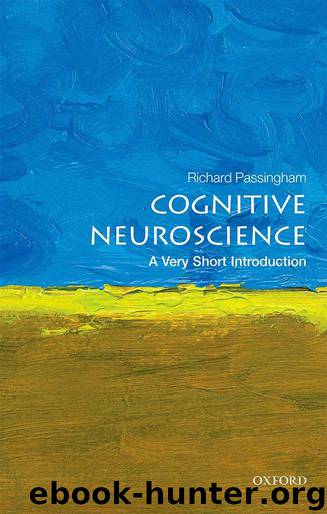Cognitive Neuroscience: A Very Short Introduction (Very Short Introductions) by Richard Passingham

Author:Richard Passingham [Passingham, Richard]
Language: eng
Format: epub, azw3
ISBN: 9780191089541
Publisher: OUP Oxford
Published: 2016-09-22T06:00:00+00:00
General intelligence or g
When assessing intelligence in the clinic, both verbal and non-verbal tests are usually included. The Wechsler Adult Intelligence Scale (WAIS) is a standard test, and in its most recent version it consists of ten core subtests: four are verbal, four visuospatial, and two symbolic. Though the subtests are designed to assess different aspects of intelligence, it has long been known that the results on the different subtests tend to give similar results. It is this finding that has led to the suggestion that people differ in their general intelligence or g.
One of the verbal subtests on the WAIS is called ‘Similarities’. In this the person has to decide whether two objects or two concepts are or are not similar. This taps the ability of people to understand relations between categories. The same ability can be tested by presenting analogies and asking if they hold.
For example, in a study in Sylvia Bunge’s laboratory the analogies were shown in pictorial form. One depicted the analogy ‘painter is to brush as writer is to pen’. In the experiment, there were two ways of assessing whether the people could appreciate the analogies. One was to show them the analogy in an incomplete form and ask the participants to pick the missing item; in this case it would be ‘pen’. The other was to show them the complete analogy and ask them whether it was valid.
The associations between a painter and brush or a writer and pen are both semantic ones, like the associations between a spanner and a pair of pliers (Chapter 4). So it is not surprising that there were activations in the left middle temporal gyrus and the ventral prefrontal cortex. However, just as in the case of verbal syllogisms, there was also activation in the parietal cortex. Judging whether two relations are the same is like comparing two quantities or lengths; in other words similarity is judged in terms of equality.
It is because the parietal cortex is involved, whether the tests involve words or not, that the results for the different subtests tend to be similar. As already mentioned, the parietal cortex is interconnected with the dorsal prefrontal cortex (Figure 15, upper line) and this parietal/prefrontal system is known to be engaged across a very wide variety of cognitive tasks, even though they differ in the type of demands that they make. John Duncan has shown this for tasks that tap the ability to hold material briefly in mind, to add up numbers, or to cope with distracting cues when deciding how to respond. Because this system is engaged on such a wide range of tasks he has suggested the term ‘the multiple-demand system’; others prefer to call it ‘the executive control system’. Whichever, it is on this system that general intelligence depends.
Download
Cognitive Neuroscience: A Very Short Introduction (Very Short Introductions) by Richard Passingham.azw3
This site does not store any files on its server. We only index and link to content provided by other sites. Please contact the content providers to delete copyright contents if any and email us, we'll remove relevant links or contents immediately.
The Art of Thinking Clearly by Rolf Dobelli(10328)
Mindhunter: Inside the FBI's Elite Serial Crime Unit by John E. Douglas & Mark Olshaker(9266)
Change Your Questions, Change Your Life by Marilee Adams(7689)
Nudge - Improving Decisions about Health, Wealth, and Happiness by Thaler Sunstein(7660)
Mastermind: How to Think Like Sherlock Holmes by Maria Konnikova(7281)
The Power of Now: A Guide to Spiritual Enlightenment by Eckhart Tolle(5682)
Men In Love by Nancy Friday(5197)
Altered Sensations by David Pantalony(5071)
Factfulness: Ten Reasons We're Wrong About the World – and Why Things Are Better Than You Think by Hans Rosling(4715)
The Confidence Code by Katty Kay(4222)
Thinking in Bets by Annie Duke(4186)
Man and His Symbols by Carl Gustav Jung(4098)
The Worm at the Core by Sheldon Solomon(3454)
Why Buddhism is True by Robert Wright(3424)
Liar's Poker by Michael Lewis(3416)
Three Women by Lisa Taddeo(3393)
The Inner Life of Animals by Peter Wohlleben(3286)
Descartes' Error by Antonio Damasio(3249)
How Music Works by David Byrne(3235)
